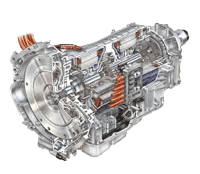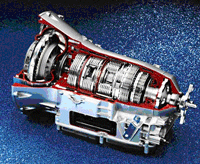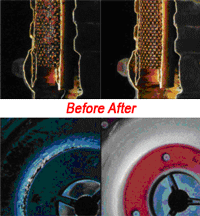|
Wynn’s Transmission Flush
- Safely removes varnish deposits and harmful sludge.
- Cleans all internal transmission components.
- Safely removes wear metal and moisture contaminants.
- Prepares automatic transmission for new fluid.
- Extends transmission fluid life.
- Helps smooth rough and hard shifting problems.
- Avoids messy transmission fluid drain and fill services.
- Avoids contact with automatic transmission fluid (ATF).
- Approved by major vehicle manufacturers.
Packaging 325 ml
|
Wynn's Automatic Transmission Flush is an automatic transmission cleaner, formulated to transform old automatic transmission fluid into a safe cleaning fluid which removes sludge and varnish deposits that could cause contamination of new transmission fluid and transmission filter plugging.
Wynn's Automatic Transmission Flush is formulated to be used in conjunction with the Wynn's Transerve® Automatic Transmission Flush and Fill Machine.
Introduction
Automobile manufacturers require scheduled transmission fluid changes in order to maintain warranty coverage. Following the warranty period, transmission fluid changes are still recommended on a specific schedule to maintain optimum condition of the transmission.
Transmission coolers, lines and torque converters are not typically drained during a traditional transmission fluid drain and fill. In fact, up to 75% of the used contaminated fluid can remain in the system. Just like motor oil and engine coolant, transmission fluid deteriorates over time, forming damaging sludge and varnish deposits.
Automatic transmission fluid becomes contaminated and oxidized differently than engine oil. There are not combustion gases or "soot" loading or fuel dilution. The elements working against transmission fluid are extremely high pressures (hydraulic pressure as high as 300 psi), high temperatures, and constantly changing stress patterns and shearing in the torque converter. Moisture and engine coolant contamination, and temperature extremes, act to cause fluid degradation and oxidation in a similar manner that affects engine oil breakdown.
Wear metals are difficult to remove when much of the oil fluid remains in the transmission system. Much of this damaging debris stays in the transmission, slowly grinding away internal components.
According to a leading manufacturer of transmission fluid, the addition of new fluid to contaminated fluid can actually cause sludge and varnish deposits to clog filters and restrict the flow of transmission fluid. This can result in a serious malfunction, or even a complete transmission failure.
Advantages
Over 90% of automotive transmission failures are due to overheating and fluid contamination. Similar to a vehicle’s engine oil, its automatic transmission fluid (ATF) acts as a lubricant and detergent, carrying away damaging heat and contaminants, and protects the transmission against wear and premature failure. But unlike a vehicle’s engine oil, most of the ATF is not replaced with a typical drain and fill service.
In fact, the traditional automatic transmission service replaces 40 percent or less of this vital fluid. The remainder is trapped inside valve bodies, the torque converter and transmission cooler lines.
To make matters worse, the addition of fresh ATF can actually loosen damaging sludge and varnish deposits within the transmission, which can lead to faulty operation and even transmission failure. But there's a better way. Wynn's patented Transmission Flush Service.
Wynn's Transmission Flush Service utilizes specially designed equipment that hooks-up to the transmission, and with the use of Wynn's Automatic Transmission Flush, safely power flushes out old fluid and contaminants. Fresh ATF is then pumped in along with Wynn's Automatic Transmission Treatment which revitalizes the seals and O-rings of the automatic transmission.
The Wynn's Transmission Flush Service provides virtually a 100% fluid replacement, as opposed to the 25-50% replacement with conventional "drop the pan" drain and refill services. Key BenefitsA typical transmission flush replaces only 40% of contaminated fluid. Wynn's Transmission Flush removes over 95% of used fluid.
Over 90% of all automatic transmission failures are due to overheating and fluid contamination. Wynn's Transmission Flush Service safely powers away virtually all life robbing dirty fluid and contaminants, extending the life of automatic transmissions and helping to avoid costly repairs or replacement.
The Wynn's Transmission Fluid Service in conjunction with Wynn's Automatic Transmission Flush, provides the following benefits;
- Safely removes varnish deposits and harmful sludge.
- Cleans all internal transmission components.
- Safely removes wear metal and moisture contaminants.
- Prepares automatic transmission for new fluid.
- Extends transmission fluid life.
- Helps smooth rough and hard shifting problems.
- Avoids messy transmission fluid drain and fill services.
- Avoids contact with automatic transmission fluid (ATF).
- Approved by major vehicle manufacturers.
Features
- Safely removes varnish deposits and harmful sludge.
- Cleans all internal transmission components.
- Safely removes wear metal and moisture contaminants.
- Prepares automatic transmission for new fluid.
- Extends transmission fluid life.
- Helps smooth rough and hard shifting problems.
- Avoids messy transmission fluid drain and fill services.
- Avoids contact with automatic transmission fluid (ATF).
- Approved by major vehicle manufacturers.
Technical Data
| Appearance |
Clear Thin Liquid |
| Colour (Visual) |
Amber |
| Colour (ASTM D 1500) |
2.0 |
| Viscosity @ 40°C (cSt) |
30.0 (ASTM D 445) |
| Viscosity @ 100°C |
5.78 (ASTM D 445) |
| Viscosity Index |
138 (ASTM D 2270) |
| Density @ 15°C |
0.898(ASTM D 4052) |
| Flash Point (°C) PMCC |
127 (ASTM D 93) |
| Freeze Point (°C) |
-23 |
| Boiling Point (°C) |
193 |
 |
Materials Safety Data Sheet
AUTOMATIC TRANSMISSION FLUSH
|
|
Wynn's Australia Pty Ltd.
An (ITW), Illinois Tool Works Company .ABN 73 000 370 150
100 Hassall Street, Wetherill Park N.S.W. 2164
Private Bag 35, Wetherill Park DC N.S.W. 2164
|
TELEPHONE NUMBER:
(02) 9828 0900
|
|
PRODUCT IDENTIFICATION
| Product Name | Wynn's Automatic Transmission Flush |
| Other Names | 64401 325 ml |
| Recommended Use | Cleaning fluid for vehicle automatic transmissions |
| Supplier Name | Wynn's Australia Pty Ltd
An (ITW), Illinois Tool Works Company
ABN 73 000 370 150 |
| Address | 100 Hassall Street, Wetherill Park N.S.W. 2164
Private Bag 35, Wetherill Park DC N.S.W. 2164 |
| Telephone Number | (02) 9828 0900
Email : wynnsaus@wynns.net
Website : www.wynns.net |
| Emergency Phone Number | (02) 9828 0900 Monday-Friday 8.00am - 5.00pm
13 11 26 (24 hours Australia) Poisons Information Centre (PIC)
0800 764 766 (New Zealand) Poisons Information Centre (PIC) |
HAZARDS IDENTIFICATION
| Hazard Classification |
HAZARDOUS SUBSTANCE. NON-DANGEROUS GOODS.
Classified as hazardous according to the criteria of NOHSC.
Not classified as a Dangerous Good according to the criteria of the
ADG Code. |
| Risk Phrase |
R 21 Harmful in contact with skin. |
| Safety Phrase |
S 45 In case of accident or if you feel unwell, seek medical advice immediately |
COMPOSITION/INFORMATION ON INGREDIENTS
Pure substances : Not applicable - Mixture
Mixture
| Chemical Identity |
CAS Number |
Proportion |
| Solvent refined light naphthenic mineral oil. |
64741-97-5 |
>60% |
| Other non-hazardous ingredients |
- |
10 - < 30% |
FIRST AID MEASURES
| Ingestion |
If swallowed, do NOT induce vomiting. Immediately wash out mouth
with water, and then give plenty of water to drink. Seek medical
attention. |
| Skin |
If skin contact occurs, remove contaminated clothing, and flush skin
with running water. Wash affected area with soap. If irritation
persists, call for medical help |
| Eye |
If in eyes, hold eyelids apart and flush the eye continuously with running water. If irritation persists, call for medical help. |
| Inhalation |
Remove person to fresh air to avoid further inhalation |
| First Aid Facilities |
Eyewash station. |
| Advice to Doctor |
Treatment should be controlled by symptoms and clinical conditions. Emesis may be induced under medical supervision. |
FIRE FIGHTING MEASURES
| Suitable Extinguishing Media |
If swallowed, do NOT induce vomiting. Immediately wash out mouth
with water, and then give plenty of water to drink. Seek medical
attention. |
| Hazards From Combustion Products |
Thermal decomposition may produce oxides of carbon, sulphur, nitrogen, phosphorus, zinc and sodium. |
| Precautions For Fire Fighters |
Use water to cool fire-exposed containers. Combustion will produce smoke and toxic fumes. |
| Special Protective Equipment |
Fire fighters to use a self contained breathing apparatus. |
| Hazchem Code |
None allocated |
HANDLING AND STORAGE
| Precautions for Safe Handling |
Keep containers closed. Keep out of reach of children. Avoid skin and eye contact. |
| Conditions for Safe Storage |
Store in cool, well ventilated area. Combustible. Avoid heat, open flame and strong oxidising agents. |
EXPOSURE CONTROLS/PERSONAL PROTECTION
| National Exposure Standards |
| Name |
ES-TWA |
ES-STEL |
ES-Peak |
| None established for product |
- |
- |
- |
|
| Mineral Oil Mist |
5 mg/m3 |
10 mg/m3 |
|
|
| Alternative Standards |
Petroleum Oil
Mist OSHA (PEL) 5mg/m3
ACGIH (TLV-TWA) 5mg/m3
Exposure Standard means the average concentration of a particular
substance in the worker's breathing zone, exposure to which,
according to current knowledge, should not cause adverse health
effects nor cause undue discomfort to nearly all workers.
|
| Biological Limit Values |
No biological limit allocated |
| Engineering Controls |
For normal use, no ventilation is required. Use in a normal ventilated area. |
| Personal Protective Equipment |
| Respiratory Protection |
For normal use, none required. |
| Eye / Face Protection |
Safety glasses. |
| Skin Protection |
PVC or Nitrile gloves. Rubber, plastic gloves. |
| Thermal Hazards |
None allocated. |
PHYSICAL AND CHEMICAL PROPERTIES
| Appearance |
Clear thin amber liquid |
| Odour |
Mild petroleum |
| pH Value |
Not applicable |
| Vapour Pressure |
Not applicable |
| Vapour Density |
Not applicable |
| Boiling Point/Range |
>193°C |
| Freezing Point |
-23°C |
| Melting Point |
Not applicable |
| Solubility |
Negligible in water |
| Density |
0.898 @ 15°C |
| Flash Point |
127°C (PMCC) |
| Flammable Limits |
Not available |
| Ignition Temperature |
Not available |
| Viscosity |
30.0 cSt @ 40°C
5.8 cSt @ 100°C |
STABILITY AND REACTIVITY
| Chemical Stability |
Stable |
| Conditions to Avoid |
Heat, open flame. |
| Incompatible Materials |
Strong oxidising agents. |
| Hazardous Decomposition Products |
Thermal decomposition may produce oxides of carbon, sulphur, nitrogen, phosphorus, zinc and sodium.. |
| Hazardous Reactions |
Polymerization will not occur. |
TOXICOLOGICAL INFORMATION
Toxicology Information
This material has not been identified as a carcinogen by NTP, IARC OR OSHA. Contains no other ingredients now known to be hazardous as defined by OSHA 29CFR 1920.1000(z) and 29 CFR 1910.1200.
Acute Health Effects
Ingestion
If swallowed, may cause slight irritation to digestive tract. Signs and symptoms are discomfort, nausea, vomiting.
Inhalation
Vapours generated at elevated temperatures can cause irritation to respiratory tract.
Eye
Will cause irritation to the eyes on direct contact, symptoms include redness and blurred vision.
Skin
May absorb on prolonged contact. Can cause irritation to skin. Prolonged contact causes redness, defatting of skin to sensitive
individuals.
Chronic Health Effects
Skin
Prolonged and repeated contact with skin, will cause skin irritation, defatting of skin and redness
ECOLOGICAL INFORMATION
Ecotoxicity No ecotoxicological classifications.
Persistence/ Degradability This product is inherently biodegradable.
Mobility Not available.
DISPOSAL CONSIDERATIONS
Disposal Methods
Dispose of waste according to Federal, EPA, State and Local regulations. Assure conformity with all applicable regulations.
Special Precautions for Landfill or Incineration
Material suitable for disposal by incineration or landfill through an approved agent.
TRANSPORT INFORMATION
UN Number None allocated.
Proper Shipping Name Not applicable.
Class and Subsidiary
Risk Not applicable.
Packing Group Not applicable.
Special Precautions
for User None applicable.
Hazchem Code None allocated.
REGULATORY INFORMATION
Poisons Schedule None scheduled.
Hazard Category Harmful / NOHSC : 10005 (1999).
OTHER INFORMATION
Acronyms
ABN Australian Business Number
ACGIH American Conference of Governmental Industrial Hygienists
ADG Australian Dangerous Goods
AICS Australian Inventory of Chemical Substances
AS Australian Standard
CAS Chemical Abstracts Service (USA)
COC Cleveland Open Cup
EPA Environment Protection Agency (Australian States)
IARC International Agency for Research on Cancer
IP Institute of Petroleum (UK)
NIOSH National Institute for Occupational Safety and Health (USA)
NOHSC National Occupational Health and Safety Commission
(Australia)
NTP National Toxicology Program (USA)
NZS New Zealand Standard
OSHA Occupational Safety and Health Administration (USA)
PEL Permissible Exposure Level
PMCC Pensky - Martens Closed Cup
SCBA Self-Contained Breathing Apparatus
STEL Short Term Exposure Limit
SUSDP Standard for the Uniform Scheduling of Drugs and Poisons
(Australia)
TLV Threshold Limit Valve
TWA Time Weighted Average
UN United Nations
Abbreviations
cP centiPoise
cSt centiStoke
g gram
Hg Mercury
kPa kiloPascal
L litre
m3 cubic metre
mg milligram
mL millilitre
mm millimetre
°C degrees of temperature in Celsius (Centigrade)
% percent(age)
Note
This form has been prepared in accordance with the National Code of
Practice for the Preparation of Material Safety Data Sheets 2nd Edition
[NOHSC:2011 (2003)] issued by the National Occupation Health and
Safety Commission April 2003.
All information contained in this form is as accurate as possible at the
time of issue. The data contained herein is not to be taken as an
expressed or implied warranty or representation, for which Wynn's
Australia Pty Ltd assumes legal responsibility. No responsibility for
damages resulting from use of the information are given, other than
those implied mandatorily by Federal or State Government
Legislation.
|
|
|
|









